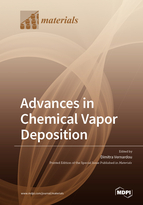Advances in Chemical Vapor Deposition
A special issue of Materials (ISSN 1996-1944). This special issue belongs to the section "Manufacturing Processes and Systems".
Deadline for manuscript submissions: closed (1 March 2020) | Viewed by 25993
Special Issue Editor
Interests: CVD; metal oxides; chromogenic materials; electrodes; batteries; capacitors
Special Issues, Collections and Topics in MDPI journals
Special Issue Information
Dear Colleagues,
We would like to invite you to submit your work to a Special Issue on “Advances in Chemical Vapor Deposition”. Chemical Vapor Deposition (CVD) is a process for producing solid products from gases. In a typical process, the reactants are transported to the substrate surface in the form of vapors and gases involving the dissociation and/or chemical reactions of gaseous reactants in an activated environment. CVD offers a compromise between efficiency, controllability and repeatability in the coverage of substrates for a range of applications including polymer coatings, large-screen displays, solar cells etc. The aim of this Special Issue is to give an overview of the latest experimental findings and identify the growth parameters and characteristics with desired qualities in terms of producing potentially useful devices.
Dr. Dimitra Vernardou
Guest Editor
Manuscript Submission Information
Manuscripts should be submitted online at www.mdpi.com by registering and logging in to this website. Once you are registered, click here to go to the submission form. Manuscripts can be submitted until the deadline. All submissions that pass pre-check are peer-reviewed. Accepted papers will be published continuously in the journal (as soon as accepted) and will be listed together on the special issue website. Research articles, review articles as well as short communications are invited. For planned papers, a title and short abstract (about 100 words) can be sent to the Editorial Office for announcement on this website.
Submitted manuscripts should not have been published previously, nor be under consideration for publication elsewhere (except conference proceedings papers). All manuscripts are thoroughly refereed through a single-blind peer-review process. A guide for authors and other relevant information for submission of manuscripts is available on the Instructions for Authors page. Materials is an international peer-reviewed open access semimonthly journal published by MDPI.
Please visit the Instructions for Authors page before submitting a manuscript. The Article Processing Charge (APC) for publication in this open access journal is 2600 CHF (Swiss Francs). Submitted papers should be well formatted and use good English. Authors may use MDPI's English editing service prior to publication or during author revisions.







